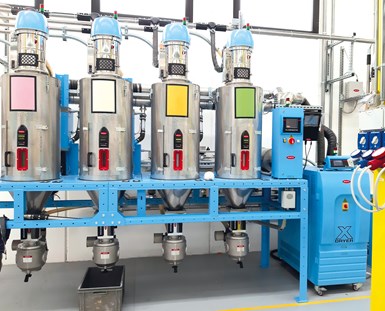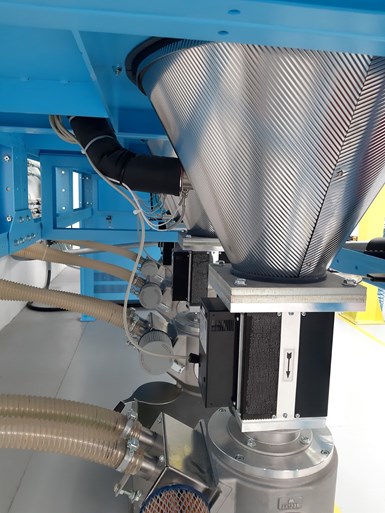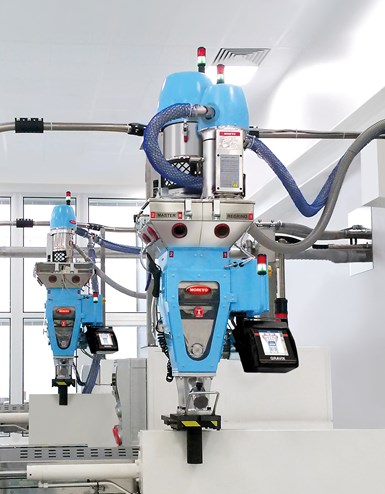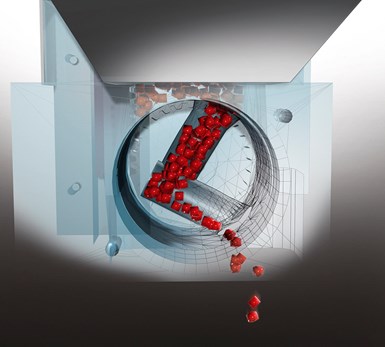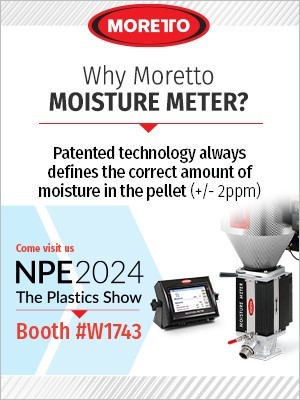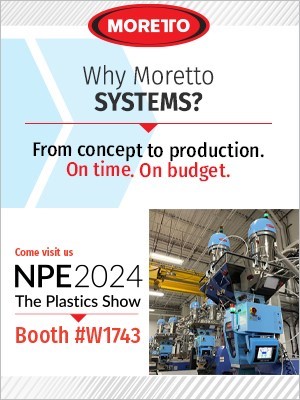Finding Efficiencies in How Components Work Together
Sponsored ContentAuxiliary systems are vital to the proper functioning of a plastic processing line, and they can be a source of major cost and efficiency improvements.
Share
Efficiency is the holy grail of every manufacturer, no matter the industry, but piecemeal attempts to tackle one system at a time can feel futile. The savings provided by an individual component can seem underwhelming, and there is always more to do, more processes to revise and systems to rethink. But tackling a production line piece by piece can blind processors to the larger perspective.
According to Moretto General Manager for North America Gene Flockerzi, the secret to creating efficient production lines is considering the line as a whole. “When you consider the entire production line,” he says, “areas of inefficiency become clearer.” Improving resin quality, reducing energy consumption and reducing scrap can be more easily achieved by looking at the process as a coherent whole.
Cutting the Cost of Moisture Control
At the start of the production line, the drying process is vital, but creates a space where users allow waste to creep in. Keeping resin at the proper temperature and moisture level at the start of the production line is vital for maintaining part quality at the end.
Here we see a Moretto drying system that enables the processor to maintain multiple resin types at the ideal temperature and dryness. The Flowmatik system automatically regulates airflow to maintain the correct drying temperature while minimizing energy consumption.
Source: All photos provided by Moretto
The key to efficient drying is understanding that there is a lot of variability in any drying process. Ambient moisture levels change with the season and plant conditions, and production levels increase and decrease with demand. Dryers must adjust to these variations, or processors risk under- or over-drying the resin, causing material defects and increased energy costs. To tackle this, Moretto’s drying system provides users with control over the entire process.
Here we can see a Moisture Meter installed directly before the processing input. This enables it to monitor the resin just as it reaches the conveyance system, preventing out-of-spec resin from reaching the mold.
One key to this is Moisture Meter — a moisture monitoring system that detects the actual moisture content of the resin rather than measuring the moisture content of the air in the hopper, passing electromagnetic waves through the resin to get highly accurate data on moisture levels. The sensor is located immediately in front of the processing input to prevent out-of-spec material from ever reaching the nozzle, and an automatic early-warning alarm keeps operators alerted to potential issues before it can affect the product.
In addition to accurate monitoring, dryers need to maintain consistency throughout the material to avoid uneven drying. In poorly designed dryers, uneven pockets of resin can form due to poor flow through the hopper, reducing the resin’s exposure to dry air and causing stagnant material to accumulate. Moretto dryers use Original Thermal eXchanger (OTX) technology, which causes the resin to flow more evenly for more predictable drying. OTX dryers use a central core that guides resin distribution and deliver airflow lower in the vessel to provide uniform drying conditions.
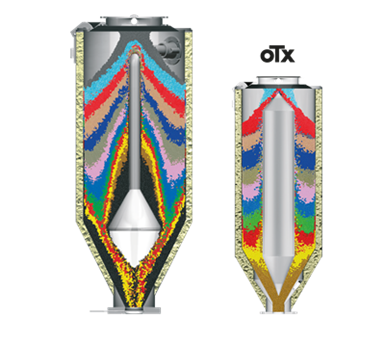
OTX hoppers use a center core that smooths resin movement with air delivery located low in the vessel for improved cone drying.
Additionally, Moretto dryers can automatically adjust to changing production speeds. “We offer variable-frequency dryers across our entire product line,” Flockerzi says. “If your production goes from 100 pounds per hour to 75 pounds per hour, the dryer automatically sense the change and will reduce airflow to maintain temperature.” It works in reverse, as well, increasing airflow as production levels increase. “With fixed-speed dryers the airflow continues at the same speed until the resin gets too hot,” Flockerzi continues. “Then, the dryer has to cool it down, and it becomes locked in a cycle of heating and cooling over and over.” This consumes more energy in both the heating and cooling cycles compared to the Moretto approach of simply reducing airflow.
At every level — the moisture monitoring, the hopper design, the variable airflow — each feature enables users to save energy costs and ensure the material is ready for processing. But the company does not limit itself to drying resin.
Zooming Out: the Integrated Production Line
After the resin leaves the dryer, other systems provide opportunities for further efficiency. Central conveying, for example, is a vital part of the process for many facilities. Adjusting the air pressure to reach the appropriate speed for moving the material without damaging it takes experience. If the air pressure gets too high, collisions can cause the buildup of angel hair and dust that can clog systems and ruin batches of resin and delay production.
Here we see a model of Moretto’s KruiseKontrol, which automatically adjusts airflow in the material conveyance system to reduce both energy consumption and damage to the material.
Thankfully, this is one area where modern technology can significantly improve the process. Moretto’s KruiseKontrol, for example, automatically adjusts airflow to match the needs of the material being used. Users can input material type and size, and the system will automatically set the airflow to the minimum needed to transfer the resin, ensuring consistent throughput while preventing material and line damage that could be caused by excessive material speeds. This has the secondary effect of reducing energy consumption, providing further savings.
And once the resin reaches its destination, blending systems provide their own opportunities for improved efficiency.
Moretto’s Gravix blenders reduce costs thanks to their extreme precision, which enables them to dramatically reduce the variability in material input and avoid the overuse of additives.
Every processor recognizes the importance of properly blending resins for maintaining quality. Variability in material input can cause inconsistencies in both the appearance and physical properties of parts, which can cause scrap. One solution to this has been to increase the input of colorants and other expensive additives, but this increases the cost of production to maintain the quality of the product. Fortunately, modern gravimetric blenders make this compromise unnecessary thanks to the incredible accuracy some can achieve.
Take the Gravix line of gravimetric blenders from Moretto — these blenders use a “Double Eyelid” dosing valve with a reaction speed of 25 milliseconds. With that reaction speed, the system boasts as little as 0.1% material weight variance, even when the bulk densities of materials differ. Contrast this method with a horizontal slide gate, which is much more likely to experience problems from material buildup. “The reaction time of the Double Eyelid valves really improves the blender’s precision, which in turn improves coloration,” says Flockerzi. “And with Rotopulse, we can release one or two pellets at a time.” This level of precision dramatically reduces the need for excessive additives to ensure quality, reducing the cost of production.
The Rotopulse system enables users to release only one or two pellets at a time, enabling processors to exercise extremely precise control over the blending process.
“Having the most precise mix has carry-on effects for the whole system,” Flockerzi says. “You reduce scrap produced, you don’t have to worry about grinding and storing that ground material. All of this reduces energy consumption and cost.” Additionally, the simple act of reducing scrap cuts down the time needed to reach production goals, meaning a processor ends up paying even less in wages and energy use per part. “Your profitability for that machine goes up every hour,” Flockerzi says.
The precision provided by features such as these eyelid shutters (with a 25-millisecond reaction time) have carry-on effects throughout the process, according to Flockerzi.
This is important to remember. A plastics production line is designed around getting resin to the nozzle in precisely the right temperature and condition to produce the product. Every increase in efficiency can therefore improve the entire process. And efficiency doesn’t end at the mechanical functions of the equipment.
Interfacing With the Production Line
Another major benefit to Moretto’s whole-system approach is the consistent user experience, as all Moretto equipment uses the same human-machine interface (HMI). “It’s a huge advantage for our customers to have this consistency of user experience,” says Flockerzi. “In addition to making training easier, it enables the equipment to easily synch together and use the MOWIS interface to meet the needs of our customers.”
MOWIS is the name of Moretto’s facility-management and monitoring software, which enables plant managers to access status reports for all connected equipment. It can interface with conveying, drying, dosing, storage and cooling systems, and it is accessible from all interfaced Moretto controls. “It works with 90% of our equipment and brings all that data together in one interface,” Flockerzi says. “It covers alarms, conditions, usage and consumption, and you have that all in one point.”
Plastics processing relies on numerous machines to get the right blend of resin at the right temperature just as it hits the nozzle. These systems feed into each other, with every improvement in efficiency building on each other to create a more cost-effective process. This makes it necessary to consider the production line as a whole, not simply as discrete units.
This means that the plant manager is navigating the same programs as personnel on the floor, easing communication and keeping everyone up-to-date on production. The manager knows what equipment is underperforming or consuming too many resources, so decisions get made quickly and workers can act on them just as fast.
“The user gets these advantages” Flockerzi concludes, “because everything works together to reinforce the efficiencies of our other equipment.” From managing resin quality to keeping the staff informed, Moretto provides solutions for the entire system.
For more information, visit moretto.com.
